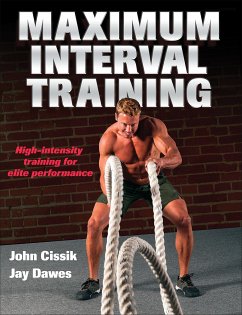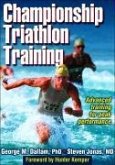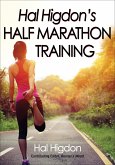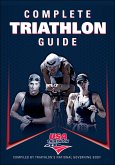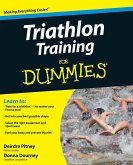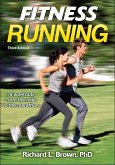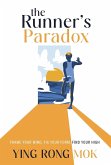19,99 €
inkl. MwSt.
Versandfertig in über 4 Wochen

10 °P sammeln
- Broschiertes Buch
- Merkliste
- Auf die Merkliste
- Bewerten Bewerten
- Teilen
- Produkt teilen
- Produkterinnerung
- Produkterinnerung
Utilizing nontraditional equipment like heavy ropes, suspension devices, and sandbags, Maximum Interval Training introduces a proven plan for developing power, strength, explosiveness, quickness, and agility. It features 147 exercises and numerous programs for athletes and serious strength and conditioning enthusiasts alike.
Andere Kunden interessierten sich auch für
![Championship Triathlon Training Championship Triathlon Training]() George M DallamChampionship Triathlon Training17,99 €
George M DallamChampionship Triathlon Training17,99 €![Hal Higdon's Half Marathon Training Hal Higdon's Half Marathon Training]() Hal HigdonHal Higdon's Half Marathon Training20,99 €
Hal HigdonHal Higdon's Half Marathon Training20,99 €![Complete Triathlon Guide Complete Triathlon Guide]() Complete Triathlon Guide18,99 €
Complete Triathlon Guide18,99 €![Triathlon Training for Dummies Triathlon Training for Dummies]() Deirdre PitneyTriathlon Training for Dummies26,99 €
Deirdre PitneyTriathlon Training for Dummies26,99 €![Fitness Running Fitness Running]() Richard L BrownFitness Running18,99 €
Richard L BrownFitness Running18,99 €![Walking Walking]() Jeff GallowayWalking14,95 €
Jeff GallowayWalking14,95 €![The Runner's Paradox The Runner's Paradox]() Mok Ying RongThe Runner's Paradox27,99 €
Mok Ying RongThe Runner's Paradox27,99 €-
-
-
Utilizing nontraditional equipment like heavy ropes, suspension devices, and sandbags, Maximum Interval Training introduces a proven plan for developing power, strength, explosiveness, quickness, and agility. It features 147 exercises and numerous programs for athletes and serious strength and conditioning enthusiasts alike.
Hinweis: Dieser Artikel kann nur an eine deutsche Lieferadresse ausgeliefert werden.
Hinweis: Dieser Artikel kann nur an eine deutsche Lieferadresse ausgeliefert werden.
Produktdetails
- Produktdetails
- Verlag: Human Kinetics Publishers
- Seitenzahl: 368
- Erscheinungstermin: 2. Juni 2015
- Englisch
- Abmessung: 280mm x 220mm x 25mm
- Gewicht: 1033g
- ISBN-13: 9781492500230
- ISBN-10: 1492500232
- Artikelnr.: 41756737
- Herstellerkennzeichnung
- Libri GmbH
- Europaallee 1
- 36244 Bad Hersfeld
- gpsr@libri.de
- Verlag: Human Kinetics Publishers
- Seitenzahl: 368
- Erscheinungstermin: 2. Juni 2015
- Englisch
- Abmessung: 280mm x 220mm x 25mm
- Gewicht: 1033g
- ISBN-13: 9781492500230
- ISBN-10: 1492500232
- Artikelnr.: 41756737
- Herstellerkennzeichnung
- Libri GmbH
- Europaallee 1
- 36244 Bad Hersfeld
- gpsr@libri.de
John Cissik, MS, CSCS,*D, NSCA-CPT,*D is the president and owner of Human Performance Services, LLC (HPS), which helps athletics professionals solve their strength and conditioning needs. He coaches youth baseball, basketball, and Special Olympics sports and runs fitness classes for children with special needs. He has written 10 books and more than 70 articles on strength and speed training that have been featured in Muscle & Fitness, Iron Man, and track and field and coaching publications. He is also the author of Human Kinetics' Speed for Sports Performance DVD series. Cissik specializes in education, strength training for baseball, basketball, track and field, and speed and agility training. He has worked with athletes from high school to Olympic levels. In addition to his role at HPS, he is the director of fitness and recreation at Texas Woman's University. John is certified by the National Strength and Conditioning Association as a strength and conditioning specialist and personal trainer and by the National Academy of Sports Medicine as a personal trainer and corrective exercise specialist. He has held level I and level II certifications from USA Track and Field and was certified with the former U.S. Weightlifting Federation. Jay Dawes is an assistant professor in the department of health sciences at the University of Colorado at Colorado Springs. Before joining UCCS, Dawes was an assistant professor of kinesiology at Texas A&M at Corpus Christi and the director of education for the National Strength and Conditioning Association. Jay has worked as a strength and performance coach, personal trainer, educator, and postrehabilitation specialist for more than 15 years. A frequent presenter both nationally and internationally on topics related to health, fitness, and human performance, Dawes received his PhD from Oklahoma State University in the School of Applied Health and Educational Psychology with an emphasis in health and human performance. He is certified by the National Strength and Conditioning Association as a strength and conditioning specialist and personal trainer, by the American College of Sports Medicine as a health fitness specialist, and by USA Weightlifting as a club coach. He became a fellow of the NSCA in 2009.
Part I Maximum Interval Conditioning
Chapter 1 Advantages of Maximum Interval Training
Chapter 2 Equipment Options and Safety Considerations
Part II Maximum Interval Exercises
Chapter 3 Body-Weight Training
Chapter 4 Sprinting
Chapter 5 Medicine Balls
Chapter 6 Heavy Ropes
Chapter 7 Suspension Training
Chapter 8 Kettlebells
Chapter 9 Sandbags
Chapter 10 Other Training Formats
Part III Design of Maximum Interval Programs
Chapter 11 Testing Considerations and Variables
Chapter 12 Protocols for Measuring Fitness and Performance Parameters
Chapter 13 Interpreting Results and Setting Goals
Chapter 14 Creating a Personalized Program
Chapter 15 Using Periodization to Push Performance to the Next Level
Part IV Maximum Interval Performance Programs
Chapter 16 Power and Strength
Chapter 17 Explosiveness
Chapter 18 Endurance
Chapter 19 Quickness and Agility
Chapter 20 Tactical Training
Chapter 21 Total-Body Conditioning
Chapter 1 Advantages of Maximum Interval Training
Chapter 2 Equipment Options and Safety Considerations
Part II Maximum Interval Exercises
Chapter 3 Body-Weight Training
Chapter 4 Sprinting
Chapter 5 Medicine Balls
Chapter 6 Heavy Ropes
Chapter 7 Suspension Training
Chapter 8 Kettlebells
Chapter 9 Sandbags
Chapter 10 Other Training Formats
Part III Design of Maximum Interval Programs
Chapter 11 Testing Considerations and Variables
Chapter 12 Protocols for Measuring Fitness and Performance Parameters
Chapter 13 Interpreting Results and Setting Goals
Chapter 14 Creating a Personalized Program
Chapter 15 Using Periodization to Push Performance to the Next Level
Part IV Maximum Interval Performance Programs
Chapter 16 Power and Strength
Chapter 17 Explosiveness
Chapter 18 Endurance
Chapter 19 Quickness and Agility
Chapter 20 Tactical Training
Chapter 21 Total-Body Conditioning
Part I Maximum Interval Conditioning
Chapter 1 Advantages of Maximum Interval Training
Chapter 2 Equipment Options and Safety Considerations
Part II Maximum Interval Exercises
Chapter 3 Body-Weight Training
Chapter 4 Sprinting
Chapter 5 Medicine Balls
Chapter 6 Heavy Ropes
Chapter 7 Suspension Training
Chapter 8 Kettlebells
Chapter 9 Sandbags
Chapter 10 Other Training Formats
Part III Design of Maximum Interval Programs
Chapter 11 Testing Considerations and Variables
Chapter 12 Protocols for Measuring Fitness and Performance Parameters
Chapter 13 Interpreting Results and Setting Goals
Chapter 14 Creating a Personalized Program
Chapter 15 Using Periodization to Push Performance to the Next Level
Part IV Maximum Interval Performance Programs
Chapter 16 Power and Strength
Chapter 17 Explosiveness
Chapter 18 Endurance
Chapter 19 Quickness and Agility
Chapter 20 Tactical Training
Chapter 21 Total-Body Conditioning
Chapter 1 Advantages of Maximum Interval Training
Chapter 2 Equipment Options and Safety Considerations
Part II Maximum Interval Exercises
Chapter 3 Body-Weight Training
Chapter 4 Sprinting
Chapter 5 Medicine Balls
Chapter 6 Heavy Ropes
Chapter 7 Suspension Training
Chapter 8 Kettlebells
Chapter 9 Sandbags
Chapter 10 Other Training Formats
Part III Design of Maximum Interval Programs
Chapter 11 Testing Considerations and Variables
Chapter 12 Protocols for Measuring Fitness and Performance Parameters
Chapter 13 Interpreting Results and Setting Goals
Chapter 14 Creating a Personalized Program
Chapter 15 Using Periodization to Push Performance to the Next Level
Part IV Maximum Interval Performance Programs
Chapter 16 Power and Strength
Chapter 17 Explosiveness
Chapter 18 Endurance
Chapter 19 Quickness and Agility
Chapter 20 Tactical Training
Chapter 21 Total-Body Conditioning
